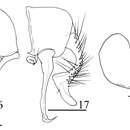pt-BR
nomes no trilho de navegação


Fannia is a very large genus of approximately 288 species of flies. The genus was originally described by the French entomologist Jean-Baptiste Robineau-Desvoidy in 1830. A number of species were formerly placed in the genus Musca.[3]
The adults have plumose arista, with the first pre-sutural dorsocentral bristle over half than half as long as the second. Males without a lower orbital bristle.[3]
 Fannia canicularis, larva
Fannia canicularis, larva Fannia is a very large genus of approximately 288 species of flies. The genus was originally described by the French entomologist Jean-Baptiste Robineau-Desvoidy in 1830. A number of species were formerly placed in the genus Musca.
Fannia est un genre d'insectes diptères brachycères de la famille des Fanniidae (mouches).
Fannia est un genre d'insectes diptères brachycères de la famille des Fanniidae (mouches).
Fannia is een geslacht van vliegen uit de familie van de Fanniidae. De wetenschappelijke naam van het geslacht werd in 1830 voorgesteld door de Franse entomoloog Jean-Baptiste Robineau-Desvoidy.[1] Hij beschreef als eerste soort Fannia saltatrix, een "uiterst algemene" soort (excessivement commune). Deze werd later beschouwd als een synoniem van Fannia scalaris (Fabricius, 1794).
Het is een uitgebreid geslacht met circa 300 beschreven soorten, waaronder de kleine kamervlieg. Ze komen wereldwijd voor; de meeste soorten worden gevonden in de gematigde streken van het noordelijk en zuidelijk halfrond. Sommige van de meest voorkomende soorten worden in landelijk gebied vaak aangetroffen in stallen waar varkens, vee of paarden worden gehouden; de larven ontwikkelen zich in de uitwerpselen en mest van de dieren. De larven van Fannia scalaris zijn vaak aan te treffen in latrines en mesthopen en F. scalaris en Fannia canicularis kunnen ook in menselijke uitwerpselen ontwikkelen. Deze, en nog andere soorten zouden ook myiasis kunnen veroorzaken bij mens en dier.[2]
Bronnen, noten en/of referentiesFannia é um gênero que contêm aproximadamente 288 espécies de moscas. O gênero foi originalmente descrito pelo entomologista francês Jean-Baptiste Robineau-Desvoidy em 1830. Ocorre, predominantemente, no meio rural. Tem importância veterinária, pois pode ser hospedeiro intermediário de Raillietina sp., transmissor de vermes espirurídeos e produz irritação nas aves, provocando perda de peso e postura. Frequentemente, se desenvolver em fezes de aves. O período de ovo a ovo leva 30 dias.
As moscas desse gênero são caracterizadas por apresentarem antena com arista nua, tamanho bem pequeno (4 à 5 mm), pernas pretas, halteres amarelos, aparelho bucal lambedor, abdômen translúcido, M1 paralela e acentuada. As larvas apresentam projeções com espinhos que funcionam como flutuadores que permitem sobreviverem em meio semi-líquido. [1]
Fannia é um gênero que contêm aproximadamente 288 espécies de moscas. O gênero foi originalmente descrito pelo entomologista francês Jean-Baptiste Robineau-Desvoidy em 1830. Ocorre, predominantemente, no meio rural. Tem importância veterinária, pois pode ser hospedeiro intermediário de Raillietina sp., transmissor de vermes espirurídeos e produz irritação nas aves, provocando perda de peso e postura. Frequentemente, se desenvolver em fezes de aves. O período de ovo a ovo leva 30 dias.
As moscas desse gênero são caracterizadas por apresentarem antena com arista nua, tamanho bem pequeno (4 à 5 mm), pernas pretas, halteres amarelos, aparelho bucal lambedor, abdômen translúcido, M1 paralela e acentuada. As larvas apresentam projeções com espinhos que funcionam como flutuadores que permitem sobreviverem em meio semi-líquido.
Rozkosny, Rudolf; Gregor, František; Pont, Adrian C. (1997). The European Fanniidae (Diptera). Acta Scientiarum Natura Lium Academiae Scienti Arum Bohemicae Brno. 31. Brno, Czech Republic: Institute of Landscape Ecology, Academy of Sciences of the Czech Republic. pp. 1–80.Fannia là một chi lớn bao gồm khoảng 288 loài ruồi. Chi này ban đầu được Jean-Baptiste Robineau-Desvoidy miêu tả năm 1830. Một số loài trong chi này trước đây được xếp vào chi Musca.[2]
||ngày truy cập= cần |url= (trợ giúp)
Fannia là một chi lớn bao gồm khoảng 288 loài ruồi. Chi này ban đầu được Jean-Baptiste Robineau-Desvoidy miêu tả năm 1830. Một số loài trong chi này trước đây được xếp vào chi Musca.